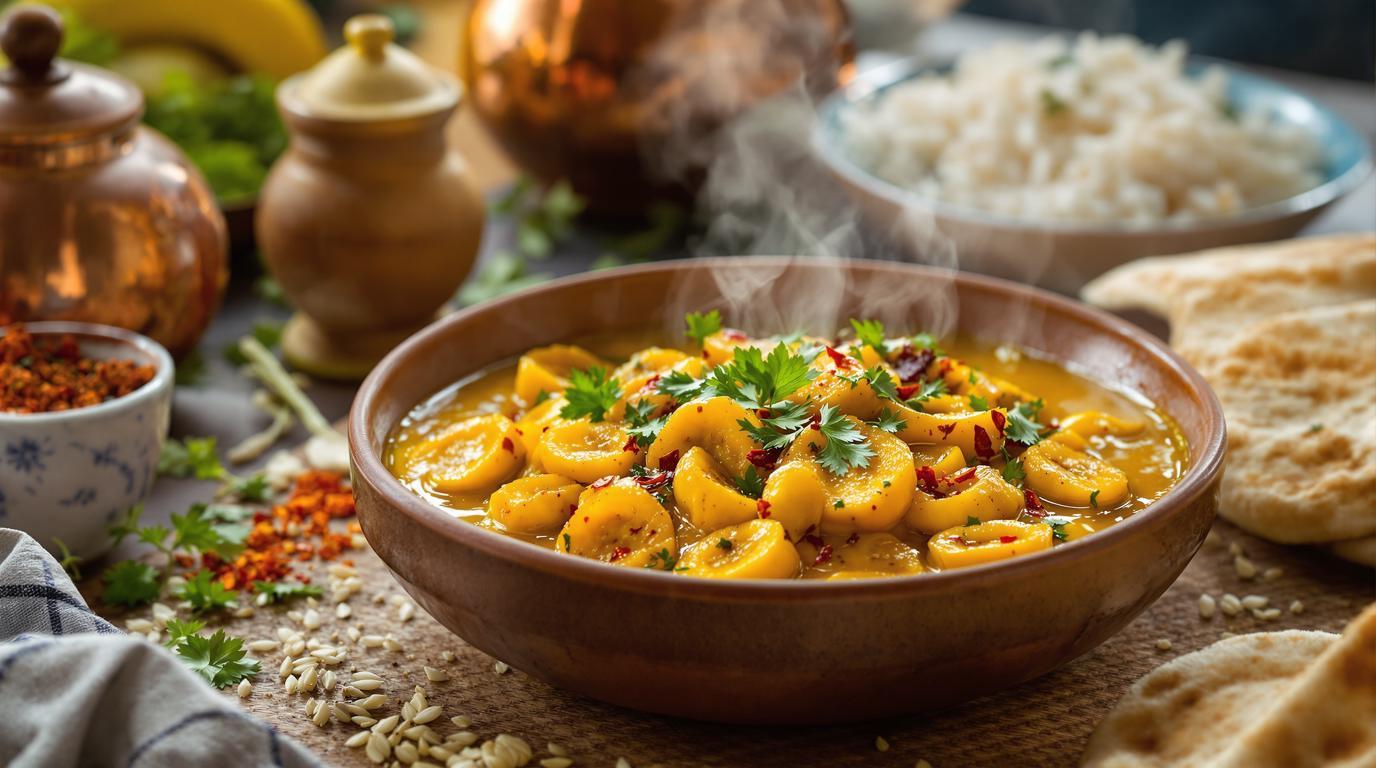There’s something deeply satisfying about transforming often-discarded food scraps into something delicious. Growing up in my grandmother’s kitchen, I watched her transform humble ingredients into culinary magic. This banana peel subzi is perhaps the ultimate example of this philosophy – a dish that turns what most people throw away into a surprisingly delicious meal rich with spices and tradition. I first encountered this recipe during my travels through Rajasthan, where a local grandmother showed me how her family had been cooking this way for generations. The revelation that banana peels could be not just edible but delectable changed my perspective on cooking forever.
The Story Behind Banana Peel Subzi 📖
This humble dish originates from the Mewar region of Rajasthan, India, where resourceful cooking practices have been passed down through generations. Long before “zero-waste cooking” became trendy, Indian grandmothers were finding ingenious ways to use every part of their precious ingredients. What struck me most was learning that banana peels actually contain higher concentrations of certain nutrients than the fruit itself – nature’s way of protecting its precious cargo.
You’ll find variations across India – southern regions add tamarind for tanginess, Gujarati versions incorporate jaggery for sweetness, while Punjabi preparations often include gram flour for a heartier consistency. What unites them all is the transformation of something typically discarded into something wonderful.
Essential Ingredients 🧾
For 4 servings, you’ll need:
- 4 banana peels (from yellow bananas with slight green tips)
- 2 tablespoons mustard or vegetable oil
- 1 medium onion, finely chopped
- 2 garlic cloves, minced
- 1 teaspoon cumin seeds
- 1 teaspoon ground turmeric
- 1 teaspoon ground coriander
- ½ teaspoon red chili powder (adjust to taste)
- 1 teaspoon salt
- ½ cup plain yogurt or chopped tomatoes
- Fresh cilantro for garnish
Step-by-Step Instructions 📝
- Prepare the peels: Wash banana peels thoroughly. Trim ends and remove any tough strings. Chop into ½-inch pieces. For less bitterness, blanch them in boiling water for 5 minutes, then drain.
- Create the tempering: Heat oil in a heavy-bottomed pan over medium heat. Add cumin seeds and let them sizzle for 30 seconds until fragrant but not burnt. This releases essential oils that form the foundation of the dish’s flavor.
- Build the base: Add chopped onions and sauté until translucent and edges begin to brown, about 5-7 minutes. Add minced garlic and cook for another minute until aromatic.
- Incorporate spices: Add turmeric, coriander, and red chili powder. Stir continuously for 1-2 minutes until spices are fragrant and well-integrated. This prevents them from burning while allowing their flavors to bloom.
- Add peels: Introduce the chopped banana peels, stirring to coat with the spice mixture. Cook for 3-4 minutes until they begin to soften and brown slightly.
- Season and simmer: Add salt and yogurt (or tomatoes), stirring well. Reduce heat to medium-low, cover, and simmer for 25-30 minutes, stirring occasionally until peels are tender and sauce has thickened.
- Finish and serve: Garnish with fresh cilantro. Serve hot with rice or flatbread.
Chef’s Note: The key to this dish is patience during the simmering process. This isn’t a quick weeknight preparation – the magic happens in that gentle, slow cooking that allows the peels to soften and absorb the flavors. If you find the peels remain bitter, add a pinch of sugar or a drizzle of honey toward the end of cooking.
Chef’s Secret Techniques 🤫
The most crucial technique here is proper peel selection. Choose peels from bananas that are yellow with slight green tips – fully ripe peels become too soft and bitter when cooked. My grandmother’s trick was to save peels throughout the week in the refrigerator, then make this dish on Sundays.
For those concerned about pesticides, using organic bananas is ideal, though a thorough washing with vinegar water (1 part vinegar to 3 parts water) helps remove surface residues. Remember that like depression-era banana bread, this recipe was born from necessity and ingenuity.
Serving & Presentation Tips 🍽️
Serve this subzi as part of a larger Indian meal alongside dal and rice, or pair it with slow-cooked pot dishes for a satisfying feast. The earthiness of this dish pairs beautifully with cooling raita (yogurt with cucumber) and makes an excellent filling for roti wraps.
For a complete experience inspired by global grandmother cooking, consider serving with traditional pie crust filled with savory ingredients, or alongside Greek Kleftiko for an international grandmother-inspired feast.
What I love most about this recipe is how it challenges our preconceptions about ingredients. Like the surprising way salt transforms coffee in Vietnam, banana peels transform from waste to wonder in this traditional preparation. The next time you enjoy a banana, remember that its humble peel might just be the star of your next culinary adventure. In our quest for sustainable cooking practices, sometimes the best teachers are the generations that came before us.
